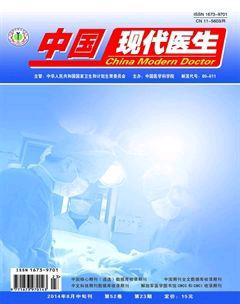右美托咪定辅助硬膜外神经阻滞无痛分娩的临床研究
胡慈贤 任秋生 王洪等
[摘要] 目的 探讨右美托咪定静脉注射辅助硬膜外神经阻滞无痛分娩的有效性以及安全性。方法 单胎足月产妇40例,随机分为两组。C组(n=20):硬膜外穿刺置管注入局麻药(0.125%罗哌卡因与芬太尼1.5 μg/mL)10 mL后实施 PCEA,单次剂量4 mL,锁定时间15 min,背景剂量4 mL/h;D组(n=20):常规硬膜外阻滞外辅助静脉注射右美托咪定0.2 μg/(kg·h)。监测ECG、RR、BP、SpO2,视觉模拟评分评估镇痛效果并观察记录产程进展、新生儿情况及不良反应。 结果 第一、二产程组间VAS评分D组优于C组(P<0.05),各组新生儿各时点 Apagr评分差异无统计学意义;第二产程C组的时间延长(P<0.05);产妇的生命体征、宫缩及胎心组间无显著性差异。结论 静脉注射右美托咪定可以优化传统无痛分娩模式,减少PCEA用药量,产妇在分娩时更加舒适。
[关键词] 右美托咪定;硬膜外神经阻滞;无痛分娩
[中图分类号] R614 [文献标识码] B [文章编号] 1673-9701(2014)23-0058-04
[Abstract] Objective To investigate the efficacy and safety of dexmedetomidine intravenous assisted epidural anesthesia for labor analgesia. Methods Forty full term puerperant who had a single fetus were randomly divided into two groups, Group C(n=20), a catheter was advanced into epidural space,anesthetic drugs(0.125% ropivacaine with fentanyl 1.5 μg/mL)of 10 ml was infused,then implement PCEA(bolus 4 mL with 15 min lockout interval,background infusion 4mL/h).Group D(n=20)assisted the routine epidural block anesthesia with intravenous injection of dexmedetomidine,which was infused 0.2 μg/(kg·h). ECG,RR,BP,SpO2,analgesic effect were assessed by VAS,labor process,mode of delivery,Apgar score of neonates and side effects of analgesia were recorded. Results The VAS during the first and second stages of labor in group D were better than group C(P<0.05),there was no significant difference in Apar score between two groups. The second stage of labor in group C had an extended period of time(P<0.05). There was no significant difference in vital signs,fetal heart rate and uterine contraction between two groups. Conclusion Intravenous dexmedetomidine can optimize the traditional labor analgesia mode and reduce the dosage of PCEA.The puerperants can be more comfortable and effective in accouchement.
[Key words] Dexmedetomidine; Epidural anesthesia; Labor analgesia
产妇分娩过程是一个剧烈疼痛的生理过程[1],无痛分娩能够有效减轻分娩疼痛,辅助产妇进行分娩。分娩镇痛方法有精神法镇痛、药物镇痛、温水浴分娩镇痛[2]以及电刺激分娩镇痛[3]、穴位配合麻醉镇痛药进行无痛分娩等,但是这些镇痛方法并不能明显地缓解分娩剧痛,低浓度局麻药硬膜外神经阻滞能有效阻滞疼痛感觉,又不影响产妇活动,成为较为理想的镇痛方法[4]。但在实际临床应用中仍会出现镇痛不足或部分运动神经阻滞等问题,或者因为产妇长时间的分娩而产生疲劳不能耐受,导致产程延长。有报道应用瑞芬太尼代替芬太尼作为硬膜外无痛分娩的镇痛药物[5],可改善镇痛效果。但麻醉药剂在产科的的选择中十分慎重, 有些麻醉药剂会严重影响新生儿呼吸循环,影响到新生儿的转归[6]。右美托咪定是一种α2-肾上腺素受体激动剂,具有抗交感、镇静和镇痛的作用[7]。Palanisamy等[8]对数例硬膜外分娩镇痛不能耐受的产妇尝试使用右美托咪定辅助无痛分娩,取得了较好的镇痛效果,且未发现明显的新生儿呼吸抑制作用。本研究将探讨静脉注射右美托咪啶辅助用于硬膜外神经阻滞无痛分娩的镇痛效果,并对新生儿娩出后基本身体状况Apagar评分的影响。
1资料与方法
1.1临床资料
选择我院2012年10月~2013年8月自愿接受分娩镇痛足月初产妇 40例。入选标准:年龄18~40岁,ASA分级Ⅰ~Ⅱ级,妊娠≥36 周,头先露,宫颈扩张≤5 cm,镇痛前VAS≥30 mm。排除标准:局麻药过敏、神经病学或神经肌肉病变、心理障碍、血液凝血异常、体重≥90 kg、身高≤150 cm、已知胎儿异常、先兆子痫以及多胎妊娠者。将40例患者随机分为两组,两组一般资料比较无明显差异(表1)。对照组(C组,n=20)采用硬膜外神经阻滞PCEA镇痛,右美托咪定组(D组,n=20)在硬膜外神经阻滞PCEA镇痛基础上辅助右美托咪定静脉注射。endprint

